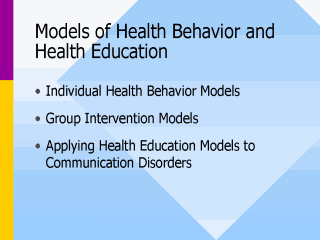| front |1 |2 |3 |4 |5 |6 |7 |8 |9 |10 |11 |12 |13 |14 |15 |16 |17 |18 |19 |20 |review |
 |
Models of
Health Behavior and Health Education A. Individual Health Behavior Model, the desire to avoid illness, disorder, or disability (or to get well), is based on the individualís belief that a specific health action will prevent or ameliorate illness, disorder, or disability (e.g., not yelling to avoid development of a voice disorder). Three components of this model are: 1. Subjective perception of health threat 2. Subjective perception of net benefits of action 3. Cues to action, or the trigger that stimulate an individual to act. B. Group Intervention Models: Social Marketing refers to the design, implementation, and control of programs seeking to increase the acceptability of a social idea or health practice in a target group; promoting ideas, not products (e.g., advertising to targets a specific behavior to avoid). C. Health Education Models: When planning prevention and promotion programs, health education models can assist in the identification of attitudes, values, and beliefs that affect on an individualís decision making or a populationís trends of behaviors (e.g., Why do physicians refer, or not refer, children for speech and language evaluations?)Transition Point: Understanding genetic predisposition for various communication disorders is also important in regard to prevention... |